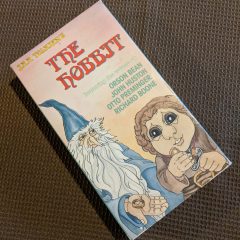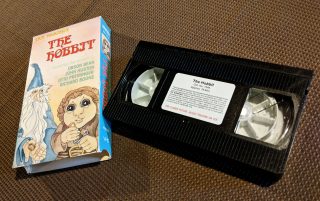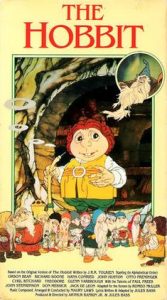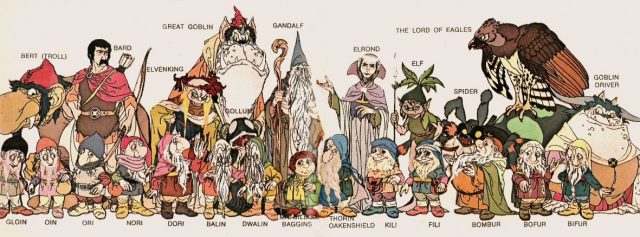
It seems odd that NBC’s made-for-TV movie of The Hobbit, which first aired on November 27, 1977, should be so divisive among fans. It is, after all, not only a faithful adaptation of the book upon which it is based but it is also the first adaption to the screen, both large and small.
That’s right, 1977; 35 years before Peter Jackson’s trilogy of the same name debuted, 24 years before Jackson’s Lord of the Rings trilogy first debuted, and one year ahead of Ralph Bakshi’s animated critically acclaimed Lord of the Ring, there was Rankin/Bass’s The Hobbit.
Personally, and by an intriguing stroke of timing, it was also the first representation of Tolkien’s work that I had ever consumed in any form besides that of the written word.
The Hobbit itself was Tolkien’s idea of a child’s novel, though this is merely a theory based upon its lightheartedness when compared with the epic Lord of the Rings trilogy which preceded it in publishing.

My VHS Copy of The Hobbit
And while it was decades ago when I first came to this film on VHS (and I don’t well remember if I saw it before or after being introduced to Bakshi’s Lord of the Rings), I can rightly remember that I had and still have an affection for the film.
Why? Because it is authentic in its approach. It doesn’t try to do too much. In fact, it does the opposite, by simplifying the plot and characters down to their essences and providing a work of art with what remains. Remember, this was the Seventies, well before computer animation, when these animation cels were hand drawn and hand painted one by one.
And that too is a reason that I enjoy this, and other older animations, because the organic nature of classic hand-drawn animation is just different than the perfection of the computer generated stuff.
 But enough of then versus now. The Hobbit was more than a well-done oversimplification of a classic story. It is also a collection of some of the great voice talent of the day.
But enough of then versus now. The Hobbit was more than a well-done oversimplification of a classic story. It is also a collection of some of the great voice talent of the day.
We’re not talking about some random collection of goblins. It’s a quality cast with Orson Bean as Bilbo Baggins; Brother Theodore as Gollum; Paul Frees (the once-upon-a-time voice of Rocky and Bullwinkle’s nemesis Boris Badenov) as Bombur; Hanna-Barbera veteran Don Messick as Balin and Lord of the Eagles among other voices; John Stephenson as Dori, Bard, and the Great Goblin; Thurl Ravenscroft (the uncredited voice on “You’re a Mean One, Mr. Grinch”) as singing Goblins; Cyril Ritchard (the Captain Hook to Mary Martin’s Peter Pan) as Elrond; Otto Preminger as The Elven King; the legendary John Huston as Gandalf; and the unmistakable voice of Glenn Yarbrough as The Balladeer singing over the adventure from time to time.
This collection of voice talent, along with the Peabody Award-winning teleplay by Romeo Muller, almost won a Hugo Award for Best Dramatic Presentation but lost out to Star Wars, the first and the only Star Wars film – remember this was 1977, a time when Empire Strikes Back wasn’t guaranteed to happen. Still, the fact that we’re talking about a made-for-TV movie competing with the original Star Wars should tell you that there is quality to this. Made-for-TV isn’t code for made-for-cheap. In fact, Jon J. O’Conner’s The New York Times review finishes with, “Whatever its flaws, this television version of ‘The Hobbit’ warrants attention,” is on the nose. To me, it’s the review equivalent of Bard’s Black Arrow finding Smaug’s weakness.
 It warrants that attention for all of the reasons I’ve already stated. For some, however, there is one more reason that has a small level of prestige over all of the others, and that is nostalgia. For anyone who, like me, came to this version of The Hobbit at a young age, there is a fondness in our recollection. For me, it did not diminish it to rewatch it, while the results of others may vary, so I still urge everyone to give it a go and press play.
It warrants that attention for all of the reasons I’ve already stated. For some, however, there is one more reason that has a small level of prestige over all of the others, and that is nostalgia. For anyone who, like me, came to this version of The Hobbit at a young age, there is a fondness in our recollection. For me, it did not diminish it to rewatch it, while the results of others may vary, so I still urge everyone to give it a go and press play.
To me, this film adaptation has “a hobbit-hole” in my soul, and since “that means comfort,” I will always watch it when I need comfort.
Is it a perfect adaptation? No, it’s not. It is a faithful adaptation, and that means straightforward storytelling. The exposition and description of Tolkien are either folded into the visual medium of animation or removed from the script for time, while the story maintains its heart throughout. And as we know from the original source material in the text and in this and other adaptations, Hobbits have heart and so does this animation.
Read the Secret File of technical information and quotes from The Hobbit (1977).